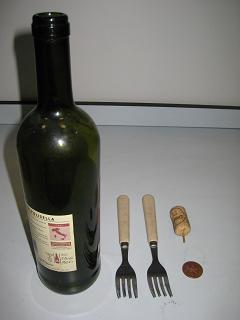Centre of mass of a body in a vertical plane
This demonstration shows that the lower the centre of mass of a body, the more stable the body.



A cork, two forks, a toothpick, a coin and a wine bottle are used in the demonstration shown in Fig. 2-8a. The procedure for the demonstration is as follows:
- Push a toothpick into one end of the cork to make a toothpick-cork system as shown in Fig. 2-8b.
- Try to make the system stand up with the toothpick in contact with the surface of a table. In practice this is not possible as the centre of mass of the system is high and easily falls outside the area of the support point. The weight of the toothpick-cork and the reaction from the surface of the table that supports the toothpick-cork are not in the same vertical line and this causes overturning of the system.
- Push two forks into opposite sides of the cork and place the coin on the top of the bottle.
- Place the toothpick-cork-fork system on the top of the coin on which the toothpick will stand in equilibrium as shown in Fig. 2-8c.
The addition of the two forks significantly lowers the centre of mass of the toothpick-cork system in the vertical plane below the contact point of the toothpick on the coin. When the toothpick-cork-fork system is placed on the coin at the top of the bottle, the system rotates until the action and reaction forces at the contact point of the toothpick are in the same line, producing an equilibrium configuration.
